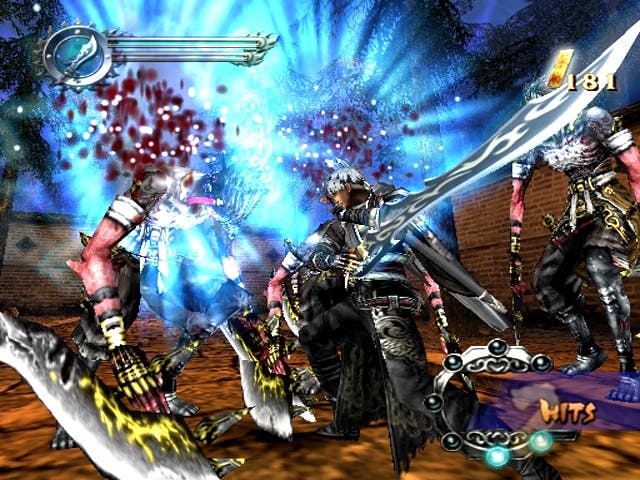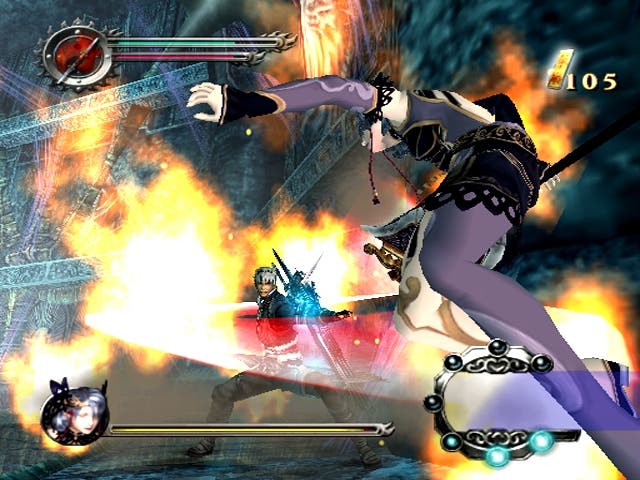Swords of Destiny
Blunt.
When Sony's marketing juggernaut stopped off at the post-E3 diner for a (currently undigested) slice of humble pie, it's a safe bet that their autopsy of that disastrous conference lingered for a moment on Genji 2. Don't get me wrong, there may be potential not yet realised in both the game and the PS3, but that hasn't stopped us all having a hearty laugh at flipping over giant enemy crabs and attacking their weak point for massive damage, engaging in spuriously authentic Japanese battles, and marvelling at such innovative features as real-time weapon change.
Those Genji lads might just be onto something with that last one, though. For, you see, when switching weapons in the creaky old PS2's Swords of Destiny, you first have to wait impatiently on a game-breaking load-screen as each is unsheathed from its digital scabbard (a wait that's unavoidable because, for some reason, nearly every weapon you own can only take a few hits before it becomes blunt and ineffective). Until the next-gen-starts-because-we-say-it-does, then, we'll just have to put up with irritating load-screens, taking that time to dream of the far-flung day when we can all jerk spasmodically at the controls of our futuristic jet fighters.
But you didn't read this review for some facetious Sony-bashing, did you? You did? Well get over it, I've a game to criticise. After all, I may be flogging a dead horse with these PS3 jokes, but Artoon are doing exactly the same thing. Only they're doing it in terms of milking the withered udders of the old-hat martial arts action-adventure genre.
It's that age-old poorly-translated story: Lei Yun, master pupil from the Chinese province of Hakkenslashu sets out to avenge his mentor's death at the hands of the deadly Cutt-Seen, and single-handedly rescue his girl from the clutches of the hellish beasts of Renderware. And it's also that age-old story of trekking down bland corridors, repeatedly bashing the square button to dispatch enemies left, right and centre as they teleport into the room in clusters of three or four.

The trick to doing so, without blindly slashing away at everything, is to wait for the opportunity to counter an enemy when the lock-on indicator glows red (because lock-on's essential if you don't want to make an enemy of the camera as well) during or after their attack. Get in a hit in that moment and you enter 'Sword Time' mode in which you flit automatically between each foe, slicing them up in quick combo succession. It's more graphically jerky than it is thrilling, but it's an essential tactic for boss fights and the only way to quickly crack the gate-controlling statues that bar progress (ostensibly by chaining an attack onto them from any nearby monsters). And it's a tactic that almost always ends up with you gracelessly knocking into a wall as the camera readjusts itself to normalcy.
Get that strategy under your belt and you're done and dusted. The background may flip from temple to mountain path and fiery cavern, yet it does nothing to disguise a lack of variety in the combat. There's a basic RPG-style experience points system to help build up your strength, but it's such a short game that you'll get to the end in about five hours despite the initial toughness of the boss battles. So constrained is its design, that to ensure you don't run off bored to the exit and finish the game in even less time, it constantly resorts to locking areas off and refusing to let you out until you've killed everything, wagging a stern finger like an admonishing parent - "Now, now, James. You're not getting any end-of-level-boss until you've slayed all your demons like a good boy."

For a genre that often revels in combat excess, it's also a little undernourished. Despite having a combo counter at the bottom of the screen it's impossible to get more than about 30 hits under your belt. Of course, such flagrant overkill doesn't necessarily make for a better game, but it does make SoD's feel less spectacular. And as easy as it is, that doesn't excuse it from the unforgivable crime of knocking you back to the start screen without so much as a by-your-leave if you do happen to die. That's not good by anyone's standards.
In a desperate attempt to strain out longevity, there's always the option to go back and do it again in the unlocked Hard mode, or roll around a second time in order to finish up your collection of swords acquired from downed enemies in the small handful of alternative stages, but by that time, you'll have acquired such a powerful weapon that any challenge is sapped out of the game entirely.
Swords of Destiny's low budget price may fairly reflect its budget sensibilities. However, there's better ways to fill a hole - the equally flawed but combo-bonkers thrill of Bujingai: Swordmaster for one. Artoon's effort lets off some fireworks but it's too sensible to toss a match into the whole box and stand well back. In the light of that, SoD falls rather blandly into current-gen middleware fodder, a foundational corpse buried beneath a glorious future of handheld rear-view mirrors and Ridge Racer.
Oh, alright. Altogether, then: Riiiidddge Raaaaceeerrr!







